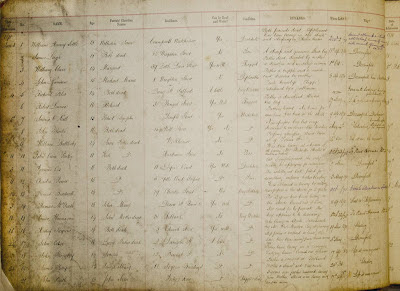Our first admission book
I’ve been attempting to do some indexing recently of our very first admission book. The archive collection for the Manchester and Salford Boys’ and Girls’ Refuges and Homes is extensive. Every child that was resident in any of our permanent homes have been recorded in varying amounts of detail. From 1886 case files were compiled on each admitted child, which comprised of material such as admittance forms, investigation forms, declaration forms and letters. All of these case files have already been indexed. Before this however the children were recorded in our admission books giving details such as age, parents names, previous address and circumstances leading up to admittance.
 | ||
| First admission book |
There are around 1500 young people recorded in this one book, which measures 100cm in length when opened. For its age it’s one of the better books within our collection in terms of condition. The information contained within is integral both for genealogists researching family members and social historians and academics.
The first boys that came into the Refuge in the early days were from the poorest of backgrounds. Whilst the charity was resident in its small terrace house on Quay Street, January 1870 to May 1871, around 130 boys were admitted. Some stayed for only a few weeks, others were later moved to the orphan homes when they were set up in 1875. It is particularly interesting to see where the boys came from here.
This basic map shows the last address given by the boys before they came into the Refuge. Many had been in Crumpsall Workhouse, but the vast majority seem to have clustered around the notorious areas of Angel Meadow, Redbank, Ancoats and Blackfriars. Running down the ‘condition’ column of these first few pages, the same words appear again and again, ‘ragged’, ‘wretched’, ‘destitute’, ‘deplorable’. Many didn’t last long in the Refuge that first year. The regimented lifestyles of the shoeblack brigades or workshops were worst for some than living their own free life on the streets. In the first six months for example, out of the 65 boys admitted to the home 24 boys ran away, eight were dismissed (often for coming home drunk) and only seven found their way back to families.
As ever I deviate when it comes to these books. The stories of these children from 140 years ago is a fascinating insight into Victorian Manchester but it’s the names that are so important to many. For hidden in this book could be your grandfather or great-grandmother. And because of this the indexing continues…

My great aunts daughter(Hannah Kemble) ended up in tetlow lane boys and girls refuge when her mother died ,times must have been really tough when you felt your child had no life with you,but Im happy to say she up getting married and moving to Haslingden lancs.Later in life she married and had a daughter ,I just hope she had a happy life x
ReplyDeleteI do hope you continue with this indexing! We know nothing of the circumstances of my husband's grandfather's family (other than both parents had died(?) in 1896. He was soon(?) admitted into care, and other family members could not/would not take him. He was at 6 George Street, Cheetham Hill, on the 1901 census. Sent to Canada in a group of 23 boys with Rev. Robert Wallace and George Jones in May 1908, he was bound for Belleville and a placement. We know nothing more of him until he married in 1912 and was living in Toronto. He had 3 children and died in 1964 in Newmarket, Ontario. He never spoke of his early years, and we know very little about the family members he left behind in Manchester. Thanks to the Refuge, he had an opportunity for a new life in Canada. I hope that one day a photograph of him will surface, or his records found. Thank you for posting this blog. Very informative and interesting!
ReplyDelete